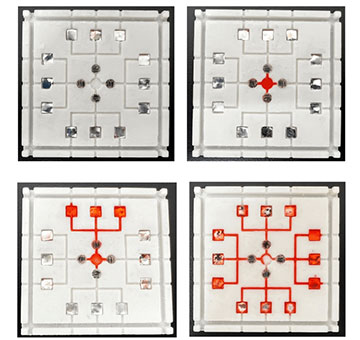
Researchers created a chip with four distinct regions, capable of rapidly testing for the presence of multiple pathogens simultaneously. [Image: Feng et al.]
Customers may grow weary of grocery recalls—discovering that the brand-new head of romaine lettuce in their refrigerator is contaminated with bacteria—but it’s still better to throw away the lettuce than to get food poisoning. Current methods for testing the food entering the market are expensive, slow and require well-trained operators, which means dangerous foodborne organisms may slip through the cracks. The World Health Organization estimates that 600 million people worldwide are affected by such contaminations every year, with 420,000 resulting deaths.
Now, researchers in China believe they have an affordable, quick and effective solution for finding harmful pathogens before they make it to the consumer (AIP Adv., doi: 10.1063/5.0208274). Their printable microfluidic chip uses light to detect up to four such pathogens simultaneously.
A new detection method
Study author Silu Feng, Guangdong University of Technology, and his colleagues recognized the limitations of the existing tools used to detect pathogens in food—like PCR and culture-based tests—and sought to design a better option. Their solution is a microfluidic chip integrated with a nanointerferometer. The chip has four distinct sections, each with three sensors made of label-free nanopore film. The sensors, fabricated with a 3D printer, are connected by a network of microfluidic channels and a 3D stop valve that allows food samples to flow automatically into the chip.
The sensors are based on optical aptamers—single-stranded DNA or RNA molecules that can selectively bind to a specific target molecule—integrated with anodic alumina oxide (AAO). AAO structures respond differently to light in relation to their chemical composition, shape and dimensions. Because of the Fabry–Perot effect, AAO’s reflectometric interference spectroscopy spectrum demonstrates well-defined peaks that are useful for sensing applications. The peaks show changes to the effective refractive index that occur as the binding molecules interact and modify the optical thickness.
Therefore, as the corresponding aptamers bind to the specific pathogens, there is a shift in the optical signal that can be measured and used to detect the presence of the pathogen. The researchers found that with this method they could identify four pathogens known for causing illness: Escherichia coli, Listeria monocytogenes, Staphylococcus aureus and Salmonella typhimurium.
The sensors were able to detect as little as 10 colony forming units (CFU) per milliliter of illness-causing bacteria (the limit of detection), far below the concentration levels that will cause food poisoning—10,000 CFU/ml.
Catching pathogens
To test the new device, Feng and colleagues created bacterial solutions and introduced them to the chip, which was illuminated by a white light source connected to an optical fiber probe. They put the sensor on a lab shaker to speed up the diffusion of the sample while continuously monitoring the optical signal through the optical fiber probe.
In incubation time tests, they found that all four pathogens took 10 to 30 minutes to saturate the sensors and for the optical signal to stabilize. The sensors were able to detect as little as 10 colony forming units (CFU) per milliliter of illness-causing bacteria (the limit of detection), far below the concentration levels that will cause food poisoning—10,000 CFU/ml. The optical shift that signals the presence of the bacteria corresponds to the amount of the pathogen present in a given sample.
In addition to having a low limit of detection, the chip is easy to manufacture in large quantities via 3D printing and doesn’t require special expertise to use. Feng explains, “This method can quickly and effectively detect multiple different pathogens, and the detection results are easy to interpret, significantly improving detection efficiency.”
